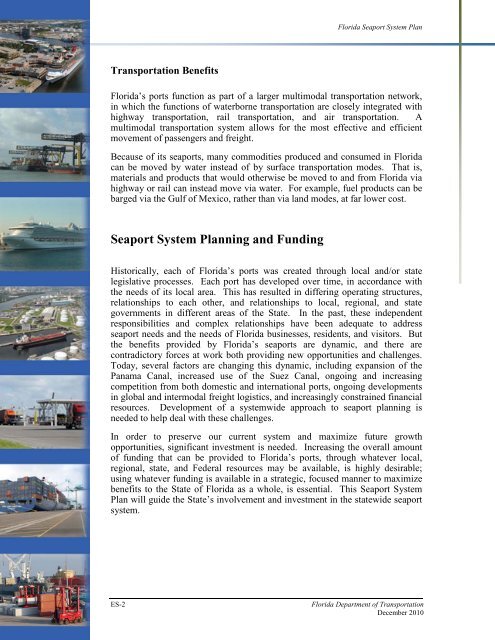Florida Seaport System Plan - SeaCIP
Florida Seaport System Plan - SeaCIP
Florida Seaport System Plan - SeaCIP
Create successful ePaper yourself
Turn your PDF publications into a flip-book with our unique Google optimized e-Paper software.
<strong>Florida</strong> <strong>Seaport</strong> <strong>System</strong> <strong>Plan</strong><br />
Transportation Benefits<br />
<strong>Florida</strong>’s ports function as part of a larger multimodal transportation network,<br />
in which the functions of waterborne transportation are closely integrated with<br />
highway transportation, rail transportation, and air transportation. A<br />
multimodal transportation system allows for the most effective and efficient<br />
movement of passengers and freight.<br />
Because of its seaports, many commodities produced and consumed in <strong>Florida</strong><br />
can be moved by water instead of by surface transportation modes. That is,<br />
materials and products that would otherwise be moved to and from <strong>Florida</strong> via<br />
highway or rail can instead move via water. For example, fuel products can be<br />
barged via the Gulf of Mexico, rather than via land modes, at far lower cost.<br />
<strong>Seaport</strong> <strong>System</strong> <strong>Plan</strong>ning and Funding<br />
Historically, each of <strong>Florida</strong>’s ports was created through local and/or state<br />
legislative processes. Each port has developed over time, in accordance with<br />
the needs of its local area. This has resulted in differing operating structures,<br />
relationships to each other, and relationships to local, regional, and state<br />
governments in different areas of the State. In the past, these independent<br />
responsibilities and complex relationships have been adequate to address<br />
seaport needs and the needs of <strong>Florida</strong> businesses, residents, and visitors. But<br />
the benefits provided by <strong>Florida</strong>’s seaports are dynamic, and there are<br />
contradictory forces at work both providing new opportunities and challenges.<br />
Today, several factors are changing this dynamic, including expansion of the<br />
Panama Canal, increased use of the Suez Canal, ongoing and increasing<br />
competition from both domestic and international ports, ongoing developments<br />
in global and intermodal freight logistics, and increasingly constrained financial<br />
resources. Development of a systemwide approach to seaport planning is<br />
needed to help deal with these challenges.<br />
In order to preserve our current system and maximize future growth<br />
opportunities, significant investment is needed. Increasing the overall amount<br />
of funding that can be provided to <strong>Florida</strong>’s ports, through whatever local,<br />
regional, state, and Federal resources may be available, is highly desirable;<br />
using whatever funding is available in a strategic, focused manner to maximize<br />
benefits to the State of <strong>Florida</strong> as a whole, is essential. This <strong>Seaport</strong> <strong>System</strong><br />
<strong>Plan</strong> will guide the State’s involvement and investment in the statewide seaport<br />
system.<br />
ES-2<br />
<strong>Florida</strong> Department of Transportation<br />
December 2010
















